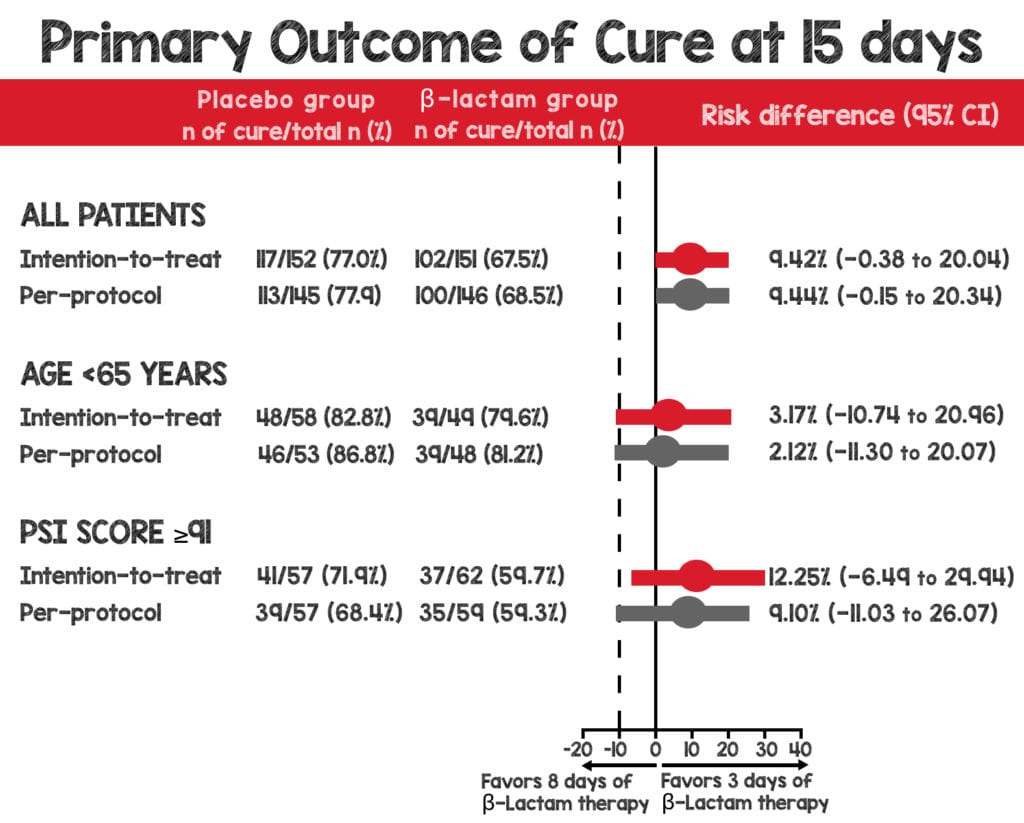
 Background:
Background:
In 2019 the World Health Organization listed “Antimicrobial Resistance” as a top 10 threat to global health. This was echoed in a 2021 document. [WHO 2019, WHO 2021] The classic medical teaching regarding antimicrobial therapy pushed for longer treatment courses. There was a commonly held myth that premature cessation or prescription of a short course of antibiotics could select for more virulent pathogens thereby re-exacerbating and intensifying illness as well as hastening the development of antibiotic resistance. However, microbial stewardship is of paramount importance and we should embrace shorter courses of antibiotics when clinically appropriate.
Current US guidelines recommend no less than 5 days of antibiotic therapy for the treatment of community-acquired pneumonia (CAP). [Metlay 2019, Woodhead 2011] While European guidelines recommend antibiotic therapy for no longer than 8 days. [Yi 2018] Despite these recommendations, a nationwide US study of more than 150,000 patients with uncomplicated CAP found the median duration of antibiotic therapy was just under 10 days, and more than 70% of patients received treatment in excess of the recommended guidelines.
We must highlight that clinical guidelines are tools and not rules. However, the excessive overprescription of antibiotics is extraordinary especially in light of the increasing microbial resistance and perceived heightened awareness as microbial stewardship task forces have become commonplace in many institutions.
Paper: Dinh A et al. Discontinuing β-Lactam Treatment After 3 Days for Patients with Community-Acquired Pneumonia in Non-Critical Care Wards (PTC): A Double-Blind, Randomised, Placebo-Controlled, Non-Inferiority Trial. Lancet 2021. PMID: 33773631
Clinical Question: Is a 3-day course of β-lactam therapy “not worse” than an 8-day course for admitted patients with CAP who are not critically ill?
What They Did:
- Multi-center, double-blind, randomized, placebo-controlled, non-inferiority trial comparing 3 days of β-lactam treatment to 8 days of β-lactam treatment in non-ICU patients admitted with CAP
-
Randomized adult patients (≥ 18 years old) admitted to the hospital with CAP after 3 days of IV or oral β-lactam treatment
-
-
- Excluded patients admitted to ICU
- Patients had to meet prespecified clinical stability criteria
-
Randomized patients (1:1):
- 5 additional days of placebo PO TID
- 5 additional days of Amoxicillin 1 gm plus Clavulanate 125 PO TID
-
-
Inclusion:
- Adult patients (≥18 years old)
- Moderately severe CAP (not in ICU)
-
Treated with IV or oral β-lactam therapy according to European guidelines
-
-
- Amoxicillin plus clavulanate OR
- 3rd generation cephalosporin (ceftriaxone or cefotaxime)
-
-
-
Clinical improvement after 72h of treatment defined by the presence of ALL stability criteria
-
-
- Apyrexia Temp < 37.8℃
- Heart rate < 100 BPM
- Respiratory rate < 100 24 BPM
- Arterial oxygenation saturation ≥ 90%
- Systolic blood pressure ≥ 90 mm Hg
- Normal mental status
-
-
Exclusion:
-
Signs of severe or complicated CAP
-
-
- Abscess
- Massive pleural effusion
- Serious chronic respiratory infection
-
-
- Immuno-suppression
- Health-care-associated pneumonia
- Any other concomitant infection necessitating antibiotic treatment
- Suspected or confirmed legionellosis
- Infection due to intracellular organism
Outcomes:
-
Primary: Cure at 15 days after start of antibiotic treatment defined by:
- Apyrexia Temp < 37.8℃
-
Resolution of clinical condition:
-
 cough frequency or severity
cough frequency or severity sputum production
sputum production SOB
SOB Crackles
Crackles
-
- No additional antibiotic treatment for CAP or any other reason since the last follow up visit
-
Secondary:
-
-
- Cure at 30 days
- All-cause mortality
- Frequency and severity of adverse events
-
Symptoms and Quality of life assessed using the community-acquired pneumonia score
- Assessed at Days: 0, 3, 8, 15, and 30
- Length of hospital stay assessed at day 15
- Recovery time at day 30
- Compliance assessed at day 15 added post hoc in all patient cured at day 15
-
-
Results:
- 706 patients assessed for eligibility
-
396 excluded
-
-
- 122 were not clinically stable
- 80 had severe or complicated pneumonia
- 80 had renal clearance < 30 mL/min
- 23 were altered
- 22 were under legal guardianship
- 22 were homeless or had no healthcare coverage
- 6 were pregnant or breastfeeding
- 41 decline participation
-
-
- 310 patients randomized to a placebo group or β-lactam group
- Patients were similar in both groups

Critical Results:
- ITT analysis on day 15:
-
-
- 117 of 152 (77%) of patients in the 3 day β-lactam group (placebo) were cured
- 102 of 151 (68%) of patients in the 8 day β-lactam group were cured
- Difference was 9.42% (95 % CI -0.38 – 20.04) indicating NONINFERIORITY
-
-
- Per-protocol analysis on day 15:
-
-
- 113 of 145 (78%) of patients in the 3 day β-lactam group (placebo) were cured
- 100 of 146 (68%) of patients in the 8 day β-lactam group were cured
- Difference was 9.44% (95% CI -0.15 – 20.34) indicating NONINFERIORITY
-
-
- Subgroup analysis: lower bound of 95% CI of the between group difference was above -10% margin in all subgroups except:
-
-
- Per-protocol subgroup for patients <65 years
- Per-protocol subgroup for patients with PSI score > 91
-
-
- ITT analysis on day 30:
-
-
- 109 of 152 (72%) of patients in the 3 day β-lactam group (placebo) were cured
- 109 of 151 (72%) of patients in the 8 day β-lactam group were cured
- Difference was -0.47% (95% CI -11.15 – 9.98)
-
-
- No difference in death rate
- No difference in adverse advents
- No difference in length of hospital stay
- No difference in median recovery time

Strengths:
- Attempts to tackle a significant healthcare dilemma—reducing antibiotic usage for a CAP
- Multicenter, double-blind, randomized study design increases external validity
- Primary and secondary outcomes were patient-oriented
- Inclusion criteria were fairly broad and easily applicable to real-world clinical practice
- Patient characteristics and disease severity were similar in both groups
- Sound randomization and blinding protocol
- High adherence to protocol in both groups
- Performed intention-to-treat and per-protocol analysis
Limitations:
- Small trial of 310 patients
-
310 patient at 16 sites over 5 years or < 4 patients per year per site
-
-
- Small number for a relatively common disease
- Likely a convenience sample
-
-
- Single country (France) where microbial resistance rates and patient-level characteristics may differ from an individual physicians practice population
- European treatment guidelines used in the study differ from the US
-
Compliance is unclear
-
-
- Patients may not have taken the remanning therapy, either placebo or antibiotics because they felt better biasing towards placebo
-
-
- Group stratification is result of post hoc analysis
-
Specific population of non-ICU admitted patients who improved after 3 days of β-lactam monotherapy
-
-
- The authors state that they believe the results could be applied to dual antibiotic regimens in the US without mention of how they came to this belief
-
-
- No attempt to identify pathogens
- Did not achieve the 90% cure rate they sought and therefore underpowered
- Biomarkers CRP and procalcitonin which may be used to guide treatment were not required
- Definition required Chest x-ray and physicians were allowed to order a CT scan if there was diagnostic uncertainty but the number of patients who had CT scans in each group was not recorded
Discussion:
- Overall, we applaud the authors for addressing a critically important global health crisis with potential for real-world applications.
- We found the patient characteristics similar to actual clinical practice.
-
We wished to see more information on vital signs and oxygen therapy
-
-
- 39% of patients were on oxygen therapy at admission
- But not all oxygen therapy is the same
-
-
-
The utility of microbial analysis in CAP is controversial and though not a requirement 85% of patients had some unspecified microbial analysis.
-
-
- Only 12% of samples were positive, much lower than the usual cited rate of 30-40%. [García-Vázquez 2004]
- This raises concern about the incidence of CAP among patients in this study
-
-
-
CT scans were permitted if there was diagnostic uncertainty but the number of scans was not recorded
-
-
- The randomization process may have made this a moot point if an equal number are in each group but we cannot be certain.
-
-
- Generally, we disapprove of post hoc analysis. However, in this paper where the placebo group (3 days of β-lactam therapy) was non-inferior to the usual treatment group (8 days of β-lactam), post hoc analysis seems reasonable to determine if there is a subgroup where 3 days of β-lactam therapy was inferior.
-
The authors projected a cure rate of 90% but only achieved approximately 70%
-
-
- If the 3 days of β-lactam therapy is truly non-inferior to 8 days of β-lactam therapy using the actual cure rate of just under 70% would require more than 700 patients
-
No resolution or improvement of symptoms was the main reason for the lack of cure in both groups
- Among these patients, 17% needed additional antibiotics in the placebo group while only 4% needed additional antibiotics in the 8 day β-lactam
-
-
- Ultimately we do not feel this change in treatment practice is ready for prime time
- Overall, it does reinforce the importance of microbial stewardship and the value of limiting treatment therapy to 5 days or less when clinically appropriate.
- In emergency medicine, this would primarily be discharged patients as we have no control of prescribing practices in hospitalized patients. In these instances, technology can drive change. I often find the easiest way to change personal prescribing patterns is to add (or subtract) medications to favorites in the EMR with the date range prespecified.
Authors Conclusion: “Among patients admitted to hospital with community-acquired pneumonia who met clinical stability criteria, discontinuing β-lactam treatment after three days was non-inferior to 8 days of treatment. These findings could allow a substantial reduction of antibiotic consumption.“
Clinical Bottom Line:
The authors found that three days of β-lactam therapy was non-inferior to 8 days of β-lactam therapy in treatment for select patients with CAP who were not admitted to the ICU. However, we believe large multinational trials are needed before instituting major practice changes.
References:
- Ten health issues WHO will tackle this year. Who.int. https://www.who.int/news-room/spotlight/ten-threats-to-global-health-in-2019. Published 2019. Accessed April 15, 2021. [Link is here]
- 10 global health issues to track in 2021. Who.int. https://www.who.int/news-room/spotlight/10-global-health-issues-to-track-in-2021. Published 2021. Accessed April 15, 2021. [Link is here]
- Metlay JP et al. Diagnosis and Treatment of Adults with Community-acquired Pneumonia. An Official Clinical Practice Guideline of the American Thoracic Society and Infectious Diseases Society of America. Am J Respir Crit Care Med 2019. PMID: 31573350
- Woodhead M et al. Guidelines for the management of adult lower respiratory tract infections–full version. Clin Microbiol Infect 2011. PMID: 21951385
- Yi SH et al. Duration of Antibiotic Use Among Adults With Uncomplicated Community-Acquired Pneumonia Requiring Hospitalization in the United States. Clin Infect Dis 2018. PMID: 29126268
- García-Vázquez ME et al. Assessment of the Usefulness of Sputum Culture for Diagnosis of Community-Acquired Pneumonia using the PORT Predictive Scoring System. Archives Intern Med 2004. PMID: 15364677
- Swaminathan A. Omadacycline, the NEJM and Non-Inferiority Studies – REBEL EM – Emergency Medicine Blog. REBEL EM – Emergency Medicine Blog. https://rebelem.com/omadacycline-the-nejm-and-non-inferiority-studies/. Published 2019. Accessed April 22, 2021.
Post Peer Reviewed By: Salim R. Rezaie, MD (Twitter: @srrezaie) and Anand Swaminathan, MD (Twitter: @EMSwami)
The post The Pneumonia Short Treatment Trial: Antibiotic Treatment for 3 days vs 8 days appeared first on REBEL EM - Emergency Medicine Blog.
